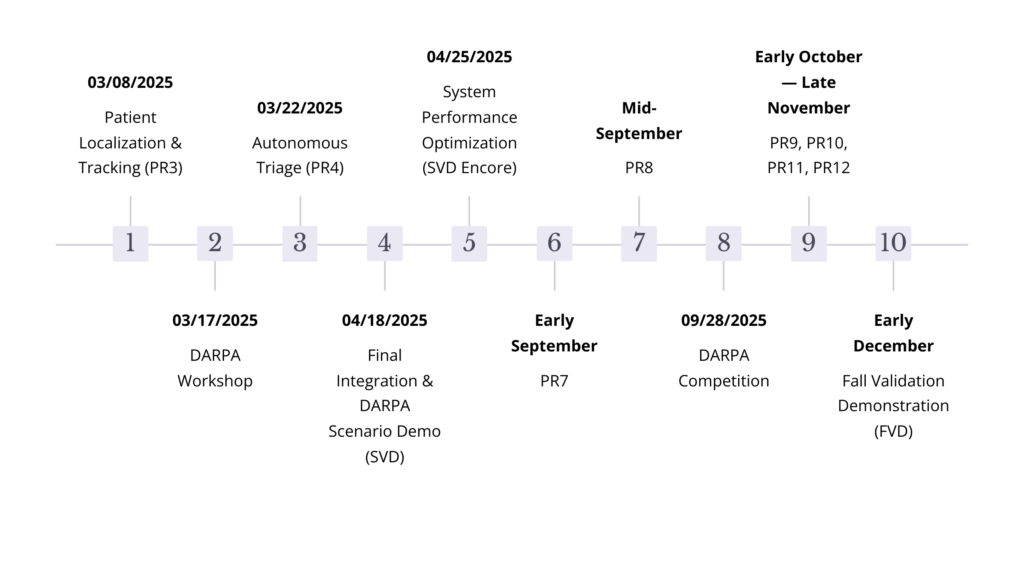
PR1 goals (Completed)
Overall system logic, member contributions, and mechanical integration.
PR2 Goals (Completed)
(link)
- Integration of patient pose algorithm, deploying the current post estimation algorithm developed by Airlab on the Jetson Orin, designed to analyze and extract head and chest orientation. Its performance will be evaluated against active benchmarks on both time and confidence metrics.
- Autonomous take off, landing and return to base lanner integrated as part of objectives within the behavior tree within MAVROS,
- Gimbal control, in terms of a ROS node that is subscribing to requested gimbal angles as desired by the algorithm either searching or locking onto a patient. Integration with Gremsy SDK to achieve a designed Roll-Pitch-Yaw of the gimbal. ROS publisher, sending back the active gimbal angles.
- Camera control. ROS subscriber: requested zoom level; ROS publisher: Current zoom level (may include current frame as image and current camera intrinsic parameter as well).
- IssacSim Pipeline – simulated version of our drone within a test environment, testing takeoff, landing, and behavior tree planner, alongside complex motions to iterate on algorithms prior to deployment to drone.
- Behavior Tree Hierarchy Draft. Change modes based on many factors. Modes should at least include: Armed/Disarmed, Takeoff, Landing, Emergency Stop, Return to launch, Initial Mapping, Searching casualty, Inspecting casualty.
PR3 Goals (completed)
- Drone System Monitor, Foxglove version, required for single operator usage to monitor both video streams and single-click actions
- Fully Integration Path Planner for Mapping the Geofence Zone; this allows us to perform a search over the entire competition area, identifying and locating patients rapidly.
- Triage Data Collection from Test Flight: Mock scorecard/algorithm system that collects streaming data from drone overflights, to then be used to train the next iteration of algorithms to improve competitive accuracy
- Auto Flight Tests with all integrated components (Path Planner for Mapping the Geofence Zone, Local Search of Patient Planner, Patient Detection Algorithm, and Patient Pose Estimation).
- Fully Integrate Local Search of Patient Planner with Behavior Tree and Patient Detection Algorithm.
- Patient Detection Algorithm: supporting the above, integrating Airlab’s existing algorithms to ID and locate patients Patient Location Estimation
- Integration of patient pose algorithm, deploying the current post estimation algorithm developed by Airlab on the Jetson Orin, designed to analyze and extract head and chest orientation. Its performance will be evaluated against active benchmarks on both time and confidence metrics.
PR4 Goals (completed)
1. Full Integration of the Path Planning algorithm for Mapping and Searching, in conjunction with Foxglove UI.
2. Patient detection integration for electro-optical camera system in the form of livestream data.
3. Patient re-identification integration for electro-optical camera under naive test algorithm for demonstration.
4. Test of patient pose detection algorithm for lower-level hover.
5. Object and patient segmentation and detection algorithm for FLIR camera.
6. Inter-UAV deconfliction (naive)
7. Mechanical overhaul of system intended for weight reduction and increased stability.
8. FLIR GPS waypoints.
PR7 Goals (completed)
1. Build and evaluate a new drone platform for the Georgia competition:
This new drone will:
a. Sustain a flight time exceeding 25 minutes, to encompass the 20 minutes during the competition and a 20% safety buffer.
b. Retain the flight performance and payload capacity of the older drone model.
The primary motivation for this change is the low battery capacity of the older drone.
2. Perform a software refactor for the Georgia competition.
a. Develop a new docker container with code specialized for the 9/27 competition. This is to isolate components and create a custom build that best addresses competition needs. There will be minimal/no new real features, simply a reorganization of the existing set.
PR8 Goals (completed)
1. Geolocation validation and testing – we need to integrate our final geolocation estimation into the code, following which we’ll conduct flight tests with ground truth to validate accuracy within set parameters.
2. Integration of the DTC radio – we need to switch our radio from the Rajant DX2 to the Domotactical radio, which provides a far lighter SWaP package that performs at higher fidelity, and is synchronized with the rest of the team.
Risk Analysis:
1. Our largest risk remains the safety of the drone’s flight performance. This initially was attributed to PID tuning, but hardware does remain a factor in the drone’s roll and yaw behavior. To mitigate this, we intend to ensure that all motors are of the same specification, and to keep the drone at low velocity.
2. Our second largest risk is related to above – we’re running into budgetary limits as we near the Georgia deadline. At this point, any critical damage is likely to be unrecoverable should it occur due to budgetary and then lead time constraints. To mitigate this, we’ve strengthened the drone’s frame and perform stringent pre-flight checks prior to any flight.
PR9 Goals
- Visual-Inertial Odometry (VIO) SLAM: Begin retrofitting the drone with the VIO system.
- SWARM: Develop an initial proposal for a probabilistic algorithm, and set up a swarm simulation environment (in Python or Isaac Sim).
- Ground LiDAR System: Complete the minimal hardware setup for a handheld LiDAR device, including a Mid 360 LiDAR, a battery, and a Jetson Orin. It will be used to support the drone for obstacle avoidance.
PR10 Goals
- VIO SLAM: Finish integrating elements and firmware between MAVROS and the VIO system. Calibrate the VIO system using the initial ground frame and GPS reference point. Ensure the VIO system can reliably detect distinct markers for ground-based localization.
- SWARM: Deploy the initial swarm algorithm in the simulation environment.
- Ground LiDAR System: Finalize hardware with a Radio/Wi-Fi module for communication. Test an open-source LiDAR algorithm on the hardware and verify smooth operation.